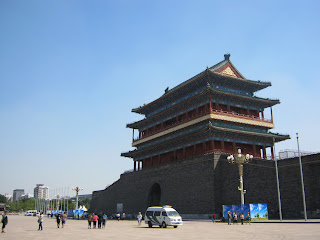For the first few months I was in Beijing, especially after learning that our winter break wouldn't start until January 14th, 2013 -- nearly four weeks after my classmates at Northern Arizona University would be starting their break -- I thought that Christmas would just come and pass much like Halloween did: without much notice on my part. Thankfully, this didn't happen, and I would have to say this is one of the many ways in which having English-speaking friends pays off while in China.
Christmas in China takes on a much more secular approach than it does in America and elsewhere -- mainly due to the government's hard stance on religion -- with Santa Claus, shopping, gifts and sales taking more and more of a presence than anything else (no matter what, though, as Christmas is still a Western holiday, not many Chinese celebrate it or aknowledge it). Nevertheless, this isn't entirely a bad thing, as when going around to the shopping centers in the more trendy parts of the city, one can be reminded that Christmas is just around the corner. On December 12th, I was able to attend a proper Christmas dinner -- with turkey, potatoes, bread, salad, etc. -- at Guómào (国贸), an area near central Beijing close to the China World Trade Center, from which it got its name (as Guómào is just an abbreviation of Zhōngguó Guójì Màoyì Zhōngxīn -- 中国国际贸易中心;China World Trade Center). The dinner itself (see above picture) was a good feast after having been on a diet of rice (米饭;Mǐfàn), and noodles (面条;Miàntiáo) for so long.
The best part of the meal, of course, were the desserts: a tiramasu (堤拉米酥;dīlāmǐsū) log (top) and a banoffee pie (bottom), which were both delicious (especially the banoffee pie, which is a mix of pie crust, condenced milk made into toffee, bananas and whipped cream, pretty awesome right?). Along with this, of course -- and not to sound cheesy or anything -- was the joy of being able to be with friends for such a meal so close to the holiday, and in a non-Western country, nonetheless.On Christmas Day we had time off from classes to celebrate, so I was able to go visit my friend Ken and his son Dre and thier friends at their home in Sānlǐtún (三里屯;Note: in the Beijing dialect -- 北京话;Běijīnghuà -- its called 三里屯儿;Sānlǐtú'er) for a Christmas lunch of fried chicken tenders, mashed potatoes, home made biscuts and salad. Following lunch, I was able to practice my Chinese with Dre's Chinese tutor Eva (far right in above picture) and relax for awhile after many weeks of studying and preparing for final exams. Also there were the Magnum's Āyí (阿姨;"Aunt" or "Auntie", a term for house workers/nannys) Weiwei (far right; pictured) and Dre's friend Bongbong (right center), all of whom I was able to talk with and get to know a little more as the time went on.
Time went quicker than I imagined, and soon everyone was leaving to go home or else go out, so I played a few rounds of darts and talked with Ken about life in Beijing thus far to kill the time, and got to find out more about the area they were in. Sanlitun is one of two most popular gathering spots for Westerners in Beijing -- the other being Wǔdàokǒu (五道口), in the Northwest of the city -- as it was an area with many night clubs, bars, fancy restaurants and Western brand stores such as Apple, Nike, and others. As such, its a nice place to visit and an even nicer place to live, as the Magnum's apartment has a good view of the neighborhood as well as the Central Business District (CBD) to the south. Not only that, but there were curious things such as the fact that some apartment buildings in the area were relatively unoccupied, as Ken said he had never seen so much as a curtain move in some buildings. While there are various reasons for this, such as real estate investment, bad building planning, or ghosts, the reason remained unknown, although it was rather fun to see it all happen before one's very eyes. Historically speaking, in the late 1950s the area was designated as the new Foreign Legation Quarter, where embassies and legations could establish themselves within the newly founded PRC. The area slowly became what it is today from the 1970s on, when bars and other establishments serving expatriats and locals began to open in the area, then shopping centers and other establishments came later, until the area became one of the many havens where foreigners to the capital flock every day and night.
At around 6 o'clock I went with Dre to get a dinner of bāozi (包子;steamed bread dumplings) and jiǎozi (饺子;dumplings) in a small restaurant a few paces from their apartment -- which according to Dre was the place to get the best baozi and jiaozi in Beijing, and I'll have to admit it was so good that I had at least three plates of the stuff. Shortly thereafter I took my leave and took the subway back to Erwai for a good night's sleep -- and the fact that I had to wake up early for class the next morning.











